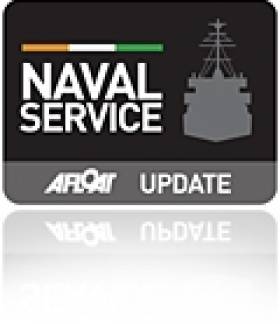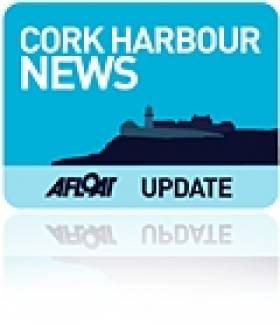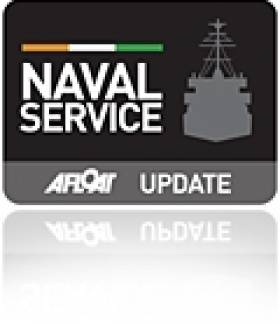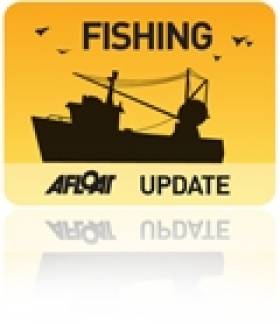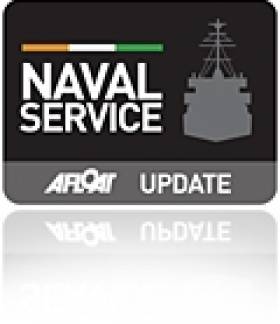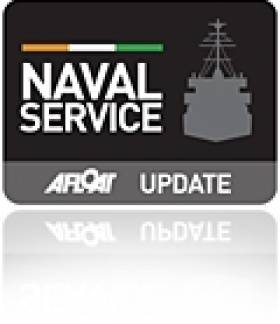Displaying items by tag: naval service
L.E. Emer Makes Farewell Patrol ‘Cruise’ in Dublin Bay
#FarewellEMER – L.E. Emer (P21) has completed a four-hour farewell patrol 'cruise' in Dublin Bay today for former crew members of the 1978 built vessel, writes Jehan Ashmore.
The Naval Service offshore patrol vessel (OPV) had on board both members of the The Naval Association and Merchant Navy and where no doubt numerous naval career stories were recalled down through the years.
She slipped her moorings this morning and departed Dun Laoghaire Harbour and made a clockwise circuit of Dublin Bay, passing the Baily Lighthouse, rounding the North Burford bouy and then proceeded south before reaching off Killiney Bay.
In calm sunlight seas she stayed in these waters before slipping through Dalkey Sound to Scotsman's Bay and off Sanycove Point, she also momentarily took some time there before she headed to dock in Dublin Port just after lunchtime.
At the next berth is the French Navy's mine-warfare vessel Croix du Sud which arrived this morning.
Yesterday, L.E. Emer made the short passage from an anchorage call off Skerries to Dun Laoghaire Harbour where tours of the vessel were made to the public while berthed at Carlisle Pier.
As previously reported, L.E. Emer is to be de-commissioned on 20 September and in the following month a pubic auction is to take place to sell the 35 year veteran unless previously sold.
L.E. Emer to Make Final Farewell Visit to Dun Laoghaire Harbour
#FarewellEMER – L.E. Emer (P21) the oldest member of the eight-strong Naval Service fleet is to make her final scheduled visit to Dun Laoghaire Harbour tomorrow, writes Jehan Ashmore.
As previously reported, L.E. Emer is making her final patrol before she de-commissioning on 20 September. The offshore patrol vessel (OPV) will go for sell unless previously sold at a public auction to be held on 23 October. A sister, L.E. Aoife (P22) will likewise be disposed a year later.
Tomorrow (Sunday) afternoon L.E. Emer will be open to public tours while she is berthed alongside the Carlisle Pier. As previously reported the five-masted cruiseship Wind Surf is today docked at this same pier having sailed from Portrush via the Isle of Man.
Potential interest for the naval vessels could include the conversion of the ships for the superyacht market or use for the offshore energy supply sector or a research vessel.
They are to be replaced by a pair of larger 'Roisin' class OPV's currently under construction by Babcock Marine in Appledore, north Devon.
L.E. Emer was completed in 1978 followed by L.E. Aoife in 1980 at the Verolme Cork Dockyard (V.C.D.). Also launched from the shipyard in Rushbrooke near Cobh, the youngest sister L.E. Aisling (P23) which will remain in service.
As leadship of a trio of 'Emer' class Coastal Patrol Vessels (CPV) the series however in more recent years were re-classified as Offshore Patrol Vessels.
They are an improved version of L.E. Deirdre (P20) which was the first custom-built vessel for the Naval Service when launched from V.C.D. in 1972. She was de-commissioned in 2001 and sold for €190,000 and converted into a luxury yacht.
Naval Vessel Tours, An Example of Verolme Cork Dockyard Built Ship
#VerolmeWeekend – The Naval Service OPV L.E. Aoife (P22) which this week detained a UK registered trawler, is to be open for public tours at Cobh Deepwater Quay, as part of Cork Dockyard Workers Gathering this weekend, writes Jehan Ashmore.
Tours (2-5pm) of the Verolme Cork Dockyard built vessel commissioned in 1979 will provide access to view the second of the trio of 'Emer' offshore patrol vessels.
The leadship of this class L.E. Emer (P21) completed in 1978, is to perform her final patrol next month. As previously reported on Afloat.ie she is to be put up for public auction, if not previously sold, in late September 2013 and LE Aoife is to follow suit a year later.
The L.E. Emer and her sisters are a derivative of L.E. Deirdre (P20) and which saw the trio of OPV's modified to improve stability and increased speed. The 'Emer' class were also fitted with a bow thruster to improve manoeuvrability especially in confined waters. Noting, the 'Deirdre's bow which has a more pronounced flare compared to her newer sisters.
L.E. Deirdre was the first custom-built vessel commissioned for the Naval Service when she was launched in 1972. She was decommissioned in 2001 and sold for €190,000. She was then converted into a luxury private yacht, Santa Maria, for more details visit this Facebook page.
Of the remaining trio, L.E.Aisling (P23) dating from 1980 is the youngest. She will be retained when the pair of OPV's which are been built by Babcock Marine, Appledore in north Devon enter service in 2014 and 2015 to replace L.E. Emer and L.E. Aoife.
The newbuilds are to break with tradition as reported in that they will be named after male literary figures (L.E. Samuel Beckett and L.E. James Joyce) rather than female mythical figures.
When these newbuilds enter service they will maintain the eight-strong fleet which includes the 'flagship' L.E. Eithne (P31).
As reported earlier today, she represents the last vessel commissioned for the navy by VCD and indeed is the final ship ever to be launched from the shipyard in Rushbrooke in 1984.
During its quarter century existence, VCD built a total of 33 vessels, mostly for Irish concerns, among them Irish Shipping Ltd, B+I Line, Arklow Shipping and a handful of overseas clients to include Sealink / British Rails' 'Freightliner' division.
British Fishing Vessel Detained by Navy off Mizen Head
#FishingDetention – A British registered fishing vessel was detained yesterday by the Naval Service OPV L.É. Aoife (P22) approximately 90 nautical miles south west off Mizen Head, Co Cork.
The detention was in relation to an alleged technical breach of fishing regulations. The vessel was escorted by the L.É. Aoife to Castletownbere earlier today, and handed over to An Gardaí Síochána.
According to the Naval Service, this brings to a total of 730 vessels boarded in 2013. There have been 24 warnings issued and this is the 7th vessel detained by the Naval Service so far this year.
Fishing Vessel Sought Immediate Naval Assistance
#TrawlerRescue- An Irish registered fishing trawler the Saint Claire sought immediate assistance from the Naval Service when approximately 80 miles west of Dingle Peninsula on Thursday evening.
The OPV L.É. Niamh (P52) responded to the request as the trawler had engineering problems and was unable to generate power. Within an hour of the call the OPV had arrived on the scene.
A team boarded the Saint Claire to assess the situation which led the vessel to be taken under tow to Castletownbere, West Cork. According to the Naval Service all crew are safe and uninjured.
#FemaleCaptains -For the first time the command handover ceremony between female captains of the Naval Service took place in Waterford City quays on Friday.
The ceremony held on board L.É. Aoife (P22) saw outgoing Captain, Lieutenant Commander Erika Downing hand over to Lieutenant Commander Marie Gleeson.
Waterford was approriately the location for the historic occasion as L.É. Aoife's adopted home-port is the south-eastern city. All Naval Vessels are individually associated with ports around the coastline.
Female personnel first joined the Irish Naval Service in 1995. Eighteen years later female personnel are fully operationally deployed and integrated, making significant contributions to the Naval Service whilst advancing their careers in line with their male colleagues.
Currently one in four of serving Naval Officers are female and earlier this year the Navy promoted two female Non Commissioned Officers (NCOs) to the senior enlisted rank of Petty Officer.
Novel Nobel Names for Naval Service Newbuilds
#NavalNewNames – According to The Irish Times, the Government has decided to name the two new OPV patrol vessels after Nobel prize-winning Irish writers. The move is a departure from the policy of naming vessels after female mythical figures.
The newbuilds are to be named L.E. Samuel Beckett and L.E. James Joyce, the first of the pair is due for delivery in early 2014 and the second in 2015 respectively.
As previously reported on Afloat.ie, the keel-laying ceremony of the first of two PV90 OPV's took place more than a year ago at Babcock Marine's shipyard in north Devon. They are an enhanced version of the 'Roisin' (PV80) class and are to be 10m longer.
Irish-Registered Trawler Detained by Navy off Hook Head
#TrawlerDetained – According to The Irish Times, the Naval Service CPV LÉ Orla (P41) detained an Irish-registered fishing vessel yesterday about 50 nautical miles off Hook Head, Co Wexford.
The detention was in relation to an alleged breach of fishing regulations. The vessel was escorted last evening by the LE Orla to Dunmore East, Co Waterford and handed over to the Garda for further investigation.
This latest detention brings to 507 the total number of vessels boarded by the Naval Service in 2013, with 713 warnings issued and is the 6th vessel detained by the navy so far this year.
#JFKennedy50th- The Eternal Flame taken from the grave of former US President John F. Kennedy in Washington has arrived to Dublin Airport this morning and is to be transferred to the Naval Service in Dublin Port and carried by sea to New Ross, writes Jehan Ashmore.
This is the first time that the flame has been given permission to be taken from the Kennedy grave at Arlington National Cemetery, since the assassination of President Kennedy in June 1963.
A ceremony will be held later today when the flame is passed over from the Defence Forces to the Naval Service CPV coastal patrol vessel L.E. Orla (P41) which is berthed along Sir John Rogerson's Quay.
L.E. Orla is scheduled to depart Dublin Port mid-afternoon with the flame on board the CPV and taken to New Ross where the Wexford town is marking his 50th anniversary visit.
On Saturday, John F. Kennedy's daughters Caroline Kennedy and Jean Kennedy Smith will be guests of honour along the Quayside in New Ross accompanied by An Taoiseach Enda Kenny and where they are to use the Eternal Flame to light the Emigrant Memorial beside the replica Dunbrody famine tallship.
The flame will also be brought to the Kennedy Monument in his ancestral homeland as a final act to mark the half-century anniversary.
Navy Detain Irish Trawler off Blasket Islands
#TrawlerDetention - Naval Service OPV L.É. Niamh (P42) has detained an Irish registered fishing vessel approximately 50 nautical miles west of the Blasket Islands yesterday evening.
The detention was in relation to an alleged breach of fishing regulations. The vessel was escorted by the 'Roisin' class OPV to Castletownbere, Co Cork and arrived at 5 am this morning. The vessel is currently in the process of being handed over to An Gardaí Síochána.
This brings to 452 total vessels boarded by the Naval Service in 2013, 17 warnings issued and this is the fifth vessel detained by the Naval Service so far this year.


























